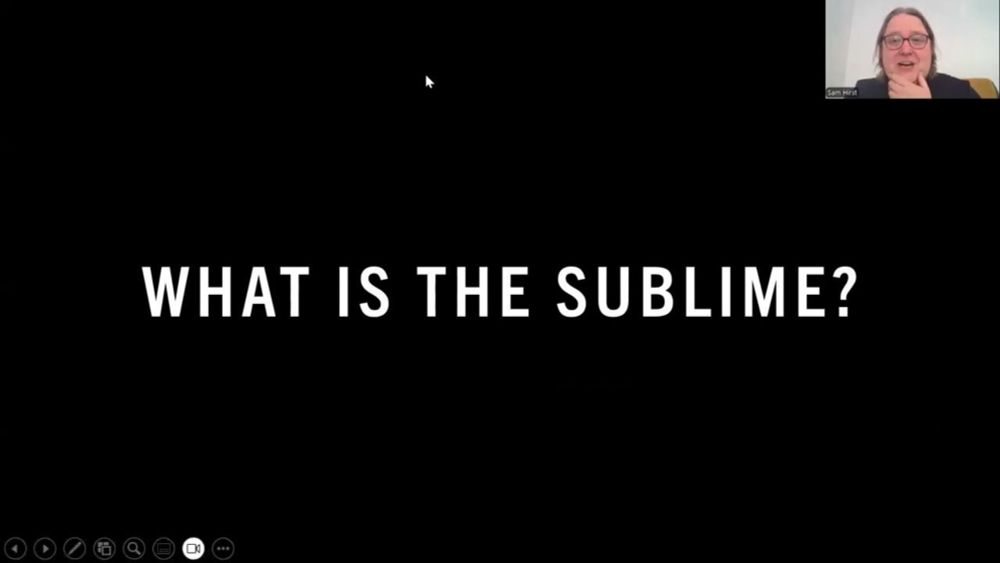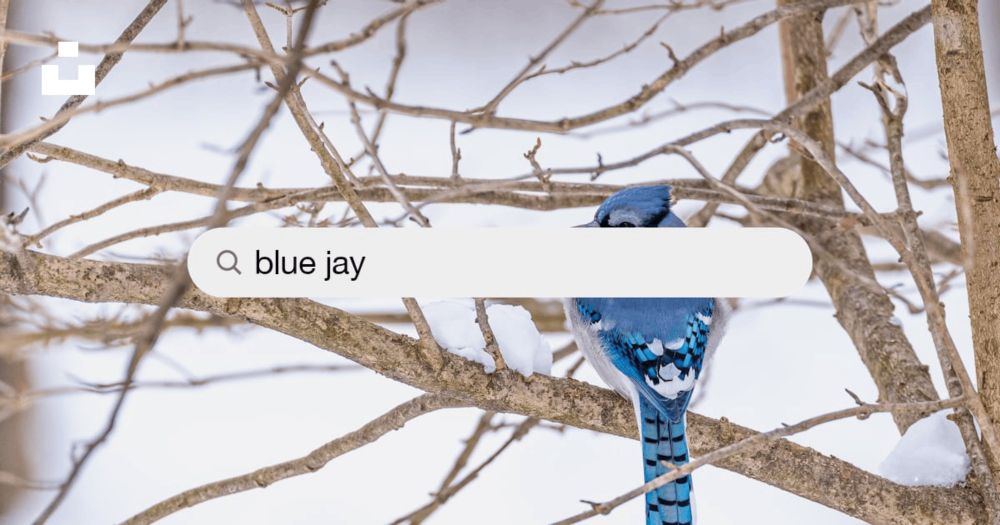Very happy to have my review of Laura Runge's "Quantitative Literary Analysis of the Works of Aphra Behn: Words of Passion" in such wonderful company (scroll down a whole bunch!)
27.08.2024 18:33 — 👍 13 🔁 5 💬 0 📌 0
❤️👍🤗
27.08.2024 14:01 — 👍 1 🔁 0 💬 0 📌 0
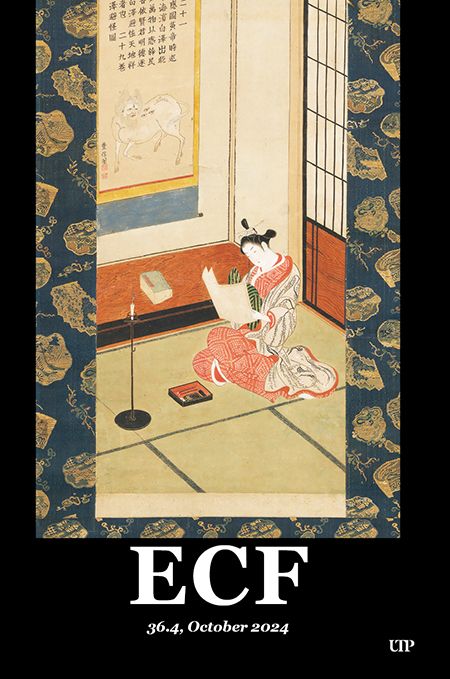
The cover of the October 2024 issue of Eighteenth-Century Fiction journal features a japanese artwork from the 18th century. In the artwork, a woman sits on the floor. She is wearing flowing robes and is reading some manuscript pages.
I sent the ECF October 2024 issue to the publisher: you know what that means!
Free to read new book reviews on the ECF journal website at McMaster University:
ecf.humanities.mcmaster.ca/ecf-36-4-oct...
#18thCentury
Thanks for reading ECF journal!
27.08.2024 13:25 — 👍 16 🔁 6 💬 0 📌 3
Project MUSE - Eighteenth-Century Fiction
These are the last few days of Managing Editor, Jacqueline Langille, as the ECF online voice (retiring!).
Signing off August 28th, with someone new taking over ECF social media in the fall.
Stay tuned for updates.
#18thCentury #C18th #18thC
Read ECF at @ProjectMUSE :
muse.jhu.edu/journal/324
26.08.2024 17:56 — 👍 12 🔁 0 💬 0 📌 1
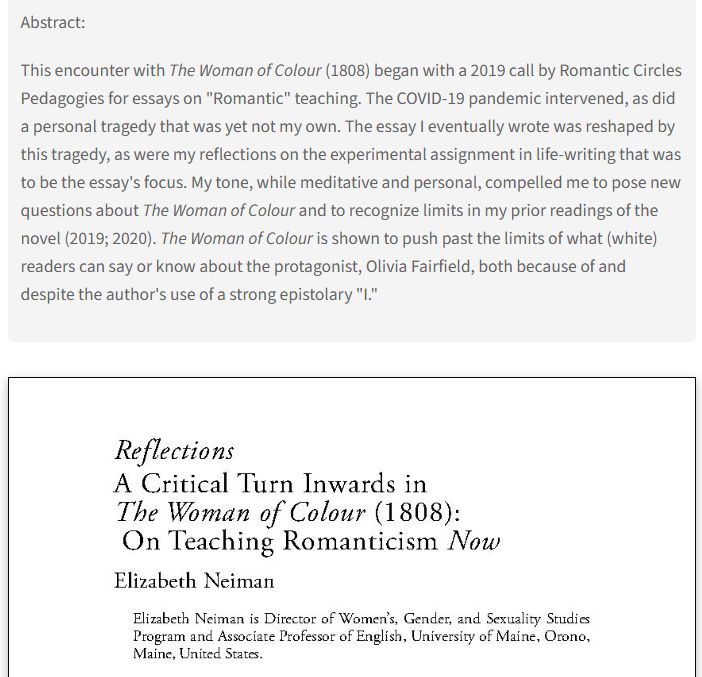
Abstract: This encounter with The Woman of Colour (1808) began with a 2019 call by Romantic Circles Pedagogies for essays on "Romantic" teaching. The COVID-19 pandemic intervened, as did a personal tragedy that was yet not my own. The essay I eventually wrote was reshaped by this tragedy, as were my reflections on the experimental assignment in life-writing that was to be the essay's focus. My tone, while meditative and personal, compelled me to pose new questions about The Woman of Colour and to recognize limits in my prior readings of the novel (2019; 2020). The Woman of Colour is shown to push past the limits of what (white) readers can say or know about the protagonist, Olivia Fairfield, both because of and despite the author's use of a strong epistolary "I."
Another amazing essay in ECF July 2024:
"A Critical Turn Inwards in /The Woman of Colour/ (1808): On Teaching Romanticism Now," by Elizabeth Neiman
ECF 36.3, pp. 459-484
muse.jhu.edu/pub/50/artic...
#18thCentury #C18th #18thC
Read ECF @ProjectMUSE !
15.08.2024 13:10 — 👍 3 🔁 2 💬 0 📌 0

Abstract: This encounter with The Woman of Colour (1808) began with a 2019 call by Romantic Circles Pedagogies for essays on "Romantic" teaching. The COVID-19 pandemic intervened, as did a personal tragedy that was yet not my own. The essay I eventually wrote was reshaped by this tragedy, as were my reflections on the experimental assignment in life-writing that was to be the essay's focus. My tone, while meditative and personal, compelled me to pose new questions about The Woman of Colour and to recognize limits in my prior readings of the novel (2019; 2020). The Woman of Colour is shown to push past the limits of what (white) readers can say or know about the protagonist, Olivia Fairfield, both because of and despite the author's use of a strong epistolary "I."
Another amazing essay in ECF July 2024:
"A Critical Turn Inwards in /The Woman of Colour/ (1808): On Teaching Romanticism Now," by Elizabeth Neiman
ECF 36.3, pp. 459-484
muse.jhu.edu/pub/50/artic...
#18thCentury #C18th #18thC
Read ECF @ProjectMUSE !
15.08.2024 13:10 — 👍 3 🔁 2 💬 0 📌 0
Project MUSE - Sébastien Brémond's Paratexts: Authorship, Genre, and Masculinity
A new ECF article in the July issue:
"Sébastien Brémond's Paratexts: Authorship, Genre, and Masculinity," by Erin Keating
ECF 36.3, July 2024, pp. 439-458
muse.jhu.edu/pub/50/artic...
#18thCentury #C18th #18thC
12.08.2024 13:54 — 👍 7 🔁 2 💬 0 📌 0
Project MUSE - Sébastien Brémond's Paratexts: Authorship, Genre, and Masculinity
A new ECF article in the July issue:
"Sébastien Brémond's Paratexts: Authorship, Genre, and Masculinity," by Erin Keating
ECF 36.3, July 2024, pp. 439-458
muse.jhu.edu/pub/50/artic...
#18thCentury #C18th #18thC
12.08.2024 13:54 — 👍 7 🔁 2 💬 0 📌 0
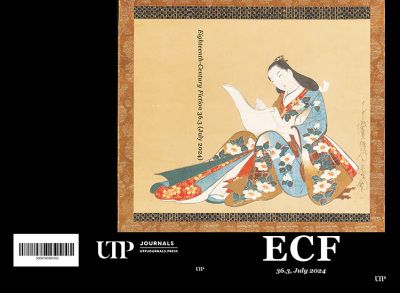
The image on the front cover is Courtesan Writing a Letter, by Kaigetsudō Doshin (ca. 1715). The digital file of this Public Domain painting is provided courtesy of The Met, New York.
Another new article in ECF July 2024:
"The Rise of Poor Richard: Franklinian Fictionality, Republican Circumspection," by Zachary Tavlin
ECF 36, Number 3, July 2024, pp. 411-438
muse.jhu.edu/pub/50/artic...
#18thCentury #C18th #18thC
Read ECF journal at Project MUSE !
31.07.2024 15:17 — 👍 3 🔁 2 💬 0 📌 0

The image on the front cover is Courtesan Writing a Letter, by Kaigetsudō Doshin (ca. 1715). The digital file of this Public Domain painting is provided courtesy of The Met, New York.
Another new article in ECF July 2024:
"The Rise of Poor Richard: Franklinian Fictionality, Republican Circumspection," by Zachary Tavlin
ECF 36, Number 3, July 2024, pp. 411-438
muse.jhu.edu/pub/50/artic...
#18thCentury #C18th #18thC
Read ECF journal at Project MUSE !
31.07.2024 15:17 — 👍 3 🔁 2 💬 0 📌 0
I'm trying to identify a late 18th-century woman writer (probably a poet) whose surname was BURNET (listed in a text from 1786 alongside Jane Graham, A-L Barbauld, Hannah Moore, Anna Seward, Hannah Cowley).
Anyone know who this might be?
#18thCentury #18C
31.07.2024 14:58 — 👍 10 🔁 13 💬 0 📌 1
#c18
29.07.2024 14:21 — 👍 3 🔁 2 💬 0 📌 0
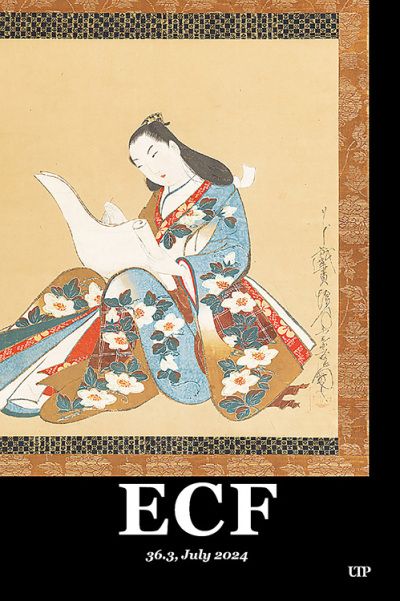
Front Cover of the July 2024 issue of ECF journal: The image is called Courtesan Writing a Letter, by Kaigetsudō Doshin (circa 1715). The digital file of this Public Domain painting is provided courtesy of The Met, New York.
New ECF article in the July 2024 issue:
"A Play to Be Read: Authorship as Marriage in Eliza Haywood's A Wife to Be Lett (1723)," by Anaclara Castro-Santana
muse.jhu.edu/pub/50/artic...
ECF 36, Number 3, July 2024, pp. 387-410
#18thCentury Please Read ECF journal at Project MUSE!
29.07.2024 14:13 — 👍 2 🔁 0 💬 0 📌 1
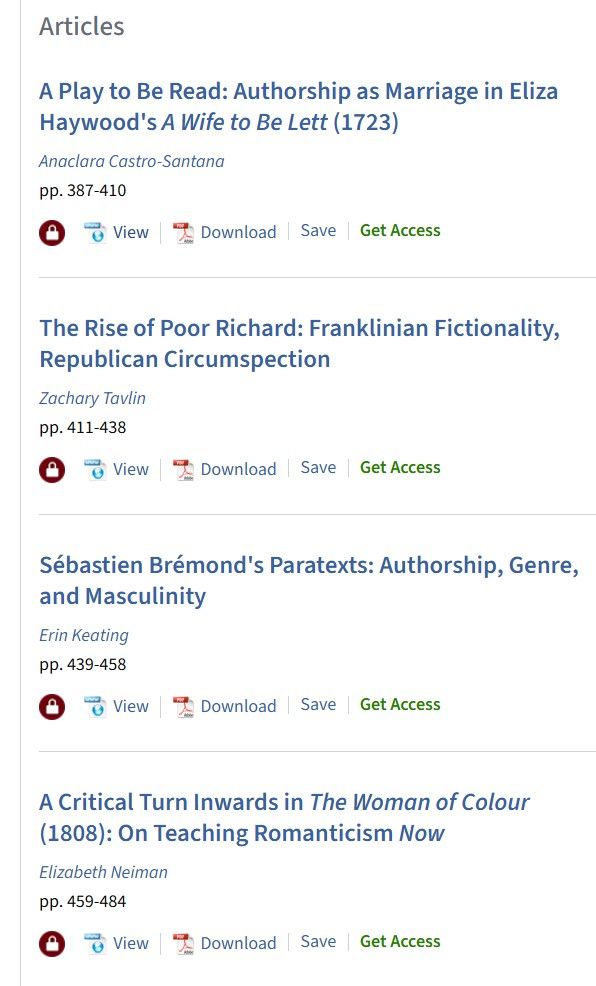
Read ECF July 2024 online:
muse.jhu.edu/issue/52797
Reading ECF on Project MUSE enables the journal to keep publishing your work.
#18thCentury
24.07.2024 18:39 — 👍 9 🔁 4 💬 0 📌 0
I take you on a deep dive into the sublime in Ann Radcliffe based on the second chapter of my book 'Theology in the Early British and Irish Gothic, 1764-1834...
Exploring Gothic Sublimity in Ann Radcliffe's Mysteries of Udolpho with Dr Sam Hirst
If you missed my latest talk on Gothic Sublimity and the work of Ann Radcliffe, you can find it here!
It's based on chapter 2 of my book 'Theology in the Early British and Irish Gothic' which has been short-listed for the Alan Lloyd Smith prize for Gothic scholarship!
youtu.be/9HCCr4Wvfjo
22.07.2024 19:34 — 👍 11 🔁 5 💬 0 📌 0
Project MUSE - Eighteenth-Century Fiction-Volume 36, Number 3, July 2024
While the ECF office is closed for a vacation week, I couldn't resist letting everyone know that the ECF July 2024 issue is now on Project MUSE:
muse.jhu.edu/issue/52797
Get your read on! #18thCentury #C18th #18thC
17.07.2024 16:43 — 👍 5 🔁 2 💬 0 📌 0
Project MUSE - Eighteenth-Century Fiction-Volume 36, Number 3, July 2024
While the ECF office is closed for a vacation week, I couldn't resist letting everyone know that the ECF July 2024 issue is now on Project MUSE:
muse.jhu.edu/issue/52797
Get your read on! #18thCentury #C18th #18thC
17.07.2024 16:43 — 👍 5 🔁 2 💬 0 📌 0
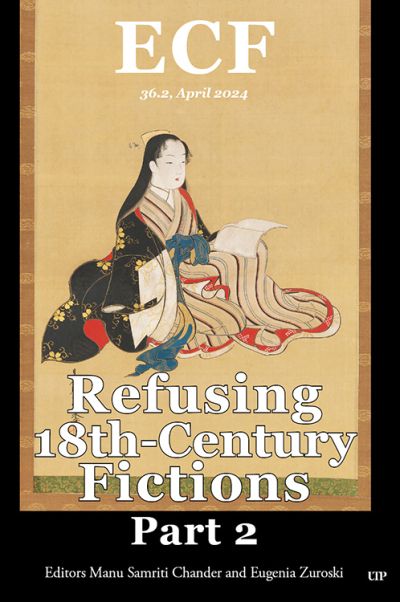
The image on the front cover of the journal Eighteenth-Century Fiction is entitled Young Woman with a Book, by Miyagawa (Katsukawa) Shunsui (mid-18th century). The digital file of this Public Domain painting is provided courtesy of The Met, New York.
Reminder:
The ECF special issue Refusing 18th-Century Fictions, Part 1 and Part 2 are available to read at Project MUSE:
Part 1: muse.jhu.edu/issue/51979
Part 2: muse.jhu.edu/issue/52266
#18thCentury #C18th #18thC
11.07.2024 19:39 — 👍 2 🔁 2 💬 0 📌 0
Fabulous poem!
10.07.2024 12:32 — 👍 1 🔁 0 💬 0 📌 0
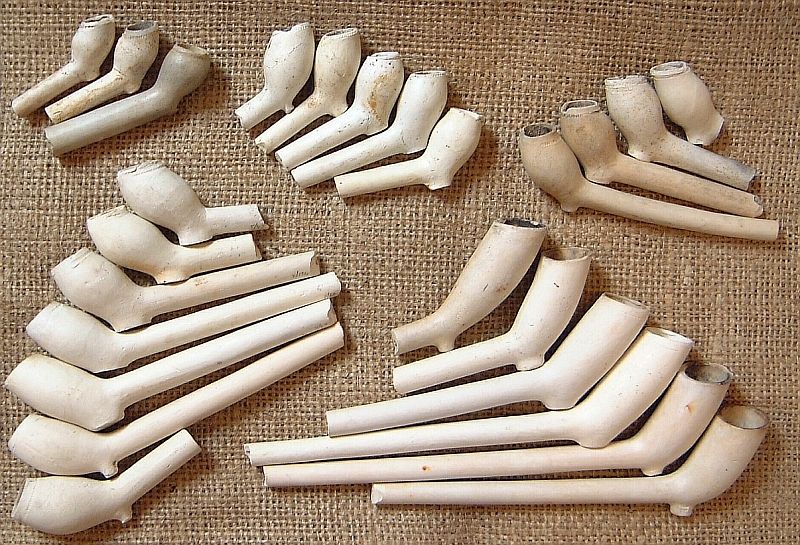
Discarded, white-clay smoking pipes, many with broken stems, likely from the early eighteenth century.
Just because it's Tuesday, I'm reposting a Material Fictions article:
"Eighteenth-Century Pipes and the Erasure of the Disposable Object," by Samuel Diener
muse.jhu.edu/article/715155
#18thCentury
Read ECF journal at Project Muse !
09.07.2024 13:13 — 👍 6 🔁 1 💬 0 📌 0
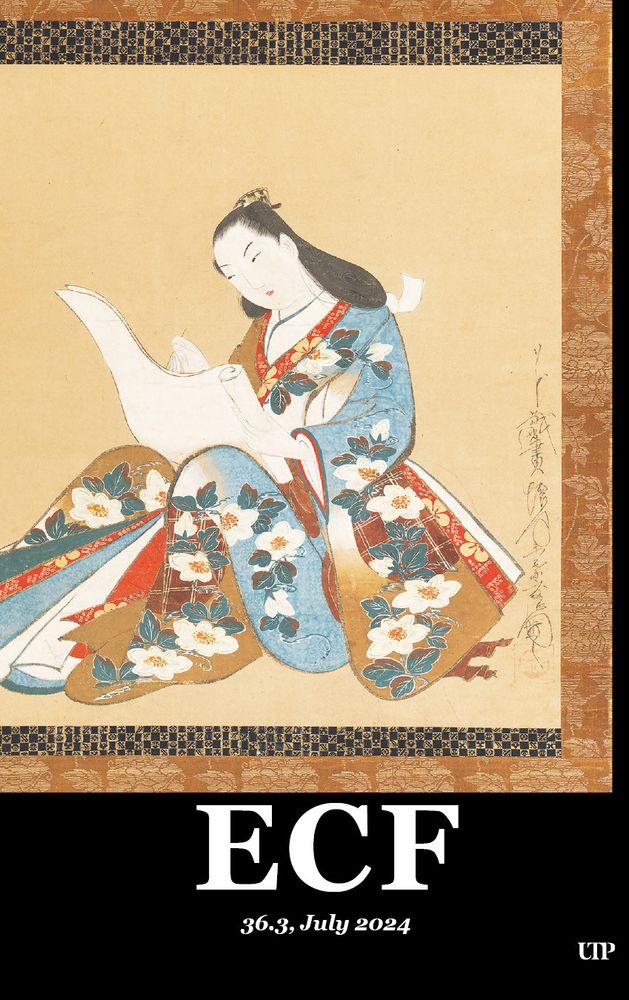
Are you ready to submit your work to ECF for consideration?
We have spots open in the October *2025* issue for research articles.
ecf.humanities.mcmaster.ca/guidelines/
Questions? ecf@mcmaster.ca
#18thCentury
Submit mc04.manuscriptcentral.com
ReadECF @ProjectMUSE
muse.jhu.edu/journal/324
08.07.2024 18:28 — 👍 2 🔁 4 💬 0 📌 0

Are you ready to submit your work to ECF for consideration?
We have spots open in the October *2025* issue for research articles.
ecf.humanities.mcmaster.ca/guidelines/
Questions? ecf@mcmaster.ca
#18thCentury
Submit mc04.manuscriptcentral.com
ReadECF @ProjectMUSE
muse.jhu.edu/journal/324
08.07.2024 18:28 — 👍 2 🔁 4 💬 0 📌 0
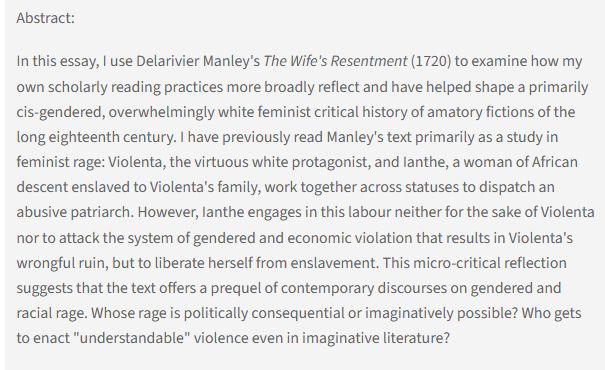
Abstract: In this essay, I use Delarivier Manley's The Wife's Resentment (1720) to examine how my own scholarly reading practices more broadly reflect and have helped shape a primarily cis-gendered, overwhelmingly white feminist critical history of amatory fictions of the long eighteenth century. I have previously read Manley's text primarily as a study in feminist rage: Violenta, the virtuous white protagonist, and Ianthe, a woman of African descent enslaved to Violenta's family, work together across statuses to dispatch an abusive patriarch. However, Ianthe engages in this labour neither for the sake of Violenta nor to attack the system of gendered and economic violation that results in Violenta's wrongful ruin, but to liberate herself from enslavement. This micro-critical reflection suggests that the text offers a prequel of contemporary discourses on gendered and racial rage. Whose rage is politically consequential or imaginatively possible? ...
A short FlashbackFriday trip to 2023:
"Troubling White Femininity: Revisiting Delarivier Manley's The Wife's Resentment (1720)," by Kirsten T. Saxton
ECF 35.4, October 2023, pp. 485-496
muse.jhu.edu/pub/50/artic...
Please Read ECF at Project MUSE !
#18thCentury #C18th #18thC
05.07.2024 12:51 — 👍 4 🔁 1 💬 0 📌 0
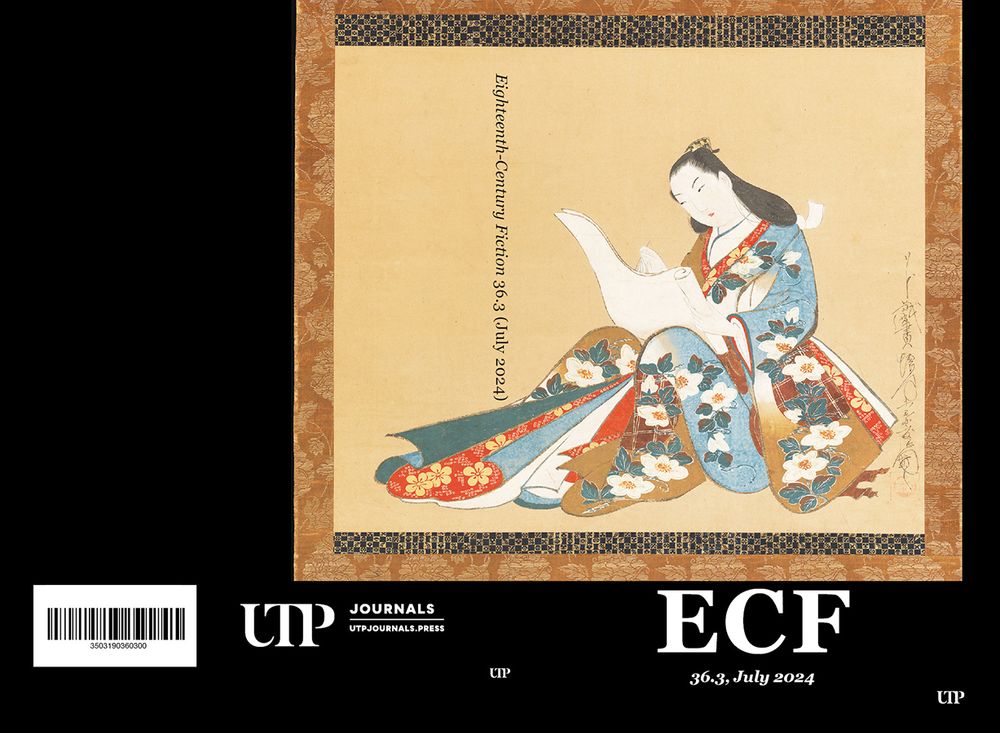
Journal cover art for ECF July 2024, Vol. 36, No. 3, shows the eighteenth-century painting entitled Courtesan Writing a Letter, by Kaigetsudō Doshin (circa 1715). The digital file of this Public Domain painting is provided courtesy of The Met, New York.
ECF July 2024 is now up at UTP Journals:
utpjournals.press/toc/ecf/36/3
Read all the abstracts at that link. Subscribe to the e-version!
On Project MUSE soon. Stay tuned for that link.
Get your read on!
#18thCentury #C18th #18thC
02.07.2024 13:04 — 👍 2 🔁 4 💬 0 📌 0

Journal cover art for ECF July 2024, Vol. 36, No. 3, shows the eighteenth-century painting entitled Courtesan Writing a Letter, by Kaigetsudō Doshin (circa 1715). The digital file of this Public Domain painting is provided courtesy of The Met, New York.
ECF July 2024 is now up at UTP Journals:
utpjournals.press/toc/ecf/36/3
Read all the abstracts at that link. Subscribe to the e-version!
On Project MUSE soon. Stay tuned for that link.
Get your read on!
#18thCentury #C18th #18thC
02.07.2024 13:04 — 👍 2 🔁 4 💬 0 📌 0
Project MUSE - Puppets, Waxworks, and a Wooden Dramatis Personae: Eighteenth-Century Material Culture and Philosophical History in William Godwin’s <i>Fleetwood</i>
An ECF article from Material Fictions just because it's Tuesday: "Puppets, Waxworks, and a Wooden Dramatis Personae: Eighteenth-Century Material Culture and Philosophical History in William Godwin’s /Fleetwood/," by Emma Peacocke muse.jhu.edu/article/704848
#ReadECF #18thCentury
25.06.2024 13:39 — 👍 3 🔁 3 💬 0 📌 0

A list of Common mistakes in choosing article keyphrases: such as (1) Using single-word terms; (2) Choosing terms or phrases that are too broad and not focused on your work – such as “eighteenth-century studies,” ...
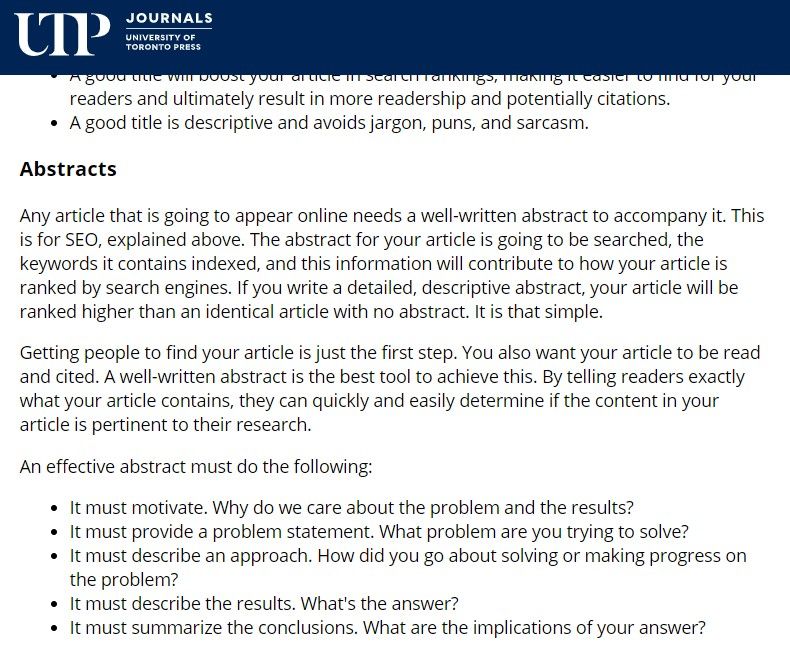
Tips from the University of Toronto Press about writing an article abstract: text begins with "Any article that is going to appear online needs a well-written abstract to accompany it." ...
Reminder:
At submission, the ECF editors do *not* require Chicago Manual of Style formatting.
Guidelines: ecf.humanities.mcmaster.ca/guidelines/
Please follow the abstract tips especially, since a convincing abstract can persuade a scholar to peer review your manuscript.
#18thCentury
19.06.2024 13:50 — 👍 2 🔁 1 💬 0 📌 0
supporting researchers counting words in various ways with computers at university of arizona libraries; increasingly displaced new englander
Vintage Internet Time Traveler
Newspapers, magazines, museums, and ephemera
Also cats & whimsy
Pennsylvania girl
Other Account: Old Timey Food @oldtimey.bsky.social
Shop: https://www.etsy.com/shop/DamesAndDahlias
Media-loving blatherskite. Ex-Duke PhD of 18th-c lit & film. Likes: searching for ecstatic truth, making strangers laugh, rambling about.
she/her; CC Prof; #translation; #17th century literature and culture; #18th century literature and culture; #early modern women writers; #networks; #intersectional feminism; #empathy
The only journal devoted solely to the interdisciplinary and global study of women and gender spanning the late medieval through early modern periods. https://www.journals.uchicago.edu/toc/emw/current
Eighteenth century diarist.
Also on Twitter as @jameswoodforde1
Account not affiliated to Parson Woodforde Society.
Translator from Russian to English. Iliazd, _Rapture_. 2019 NEA Translation Fellowship for Iliazd, _PhiloSophia_ (excerpts from Rab-Rab Press). Iliazd's _Speechless Sentence_ and excerpts from _parisites_ and _dUnkee fərEnt_ in _TYPO_ #7.
Professional 18th cent historian; woodworker; long time fiber artist (knitting, sewing, handspinning, etc); chronic reader and occasional writer
Teacher, reader, sometimes surfer.
a grumpy melange of personality defects who gets paid to make people's writing better; or, failing that, to not make it appreciably worse.
• medieval historian • history of medicine • unapologetic cat gal • quick with a gif • “she probably deserves a raise” - student eval • Tar Heel • feels WAY too much • thoughts are mine and mine alone •
Historian exploring early modern politics & ideas ▪︎ Based in Budapest, research assistant @lupspolitics.bsky.social ▪︎ General committee member @ceraejournal.bsky.social
Germanistin und Komparatistin in Erlangen
(Ich nutze diesen Account privat.)
Cultural & intellectual historian @york.ac.uk, @ihr.bsky.social, & in the wild | hows, whys, & effects of re-imagining historical homicides | #YWES editor | committee @historylabplus.bsky.social & @capnetwork.bsky.social | sarahwride.co.uk/historianforhire
Author of Lessons in Magic and Disaster (Tor Books, 2025), about a woman who teaches her mother how to do magic — and uncovers a queer scandal hidden in a 300 year old book.
SFF book critic @WashingtonPost.com. Co-host @ouropinions.bsky.social.
Book Nerd. Germany & US. Senior Lecturer of English & American Literature + EFL. Author of Representing Public Credit (2016) & The Politics of Disinterestedness (2025).
Trans* Histories of the Book in 19C America | Owner of @meanwhilelttrpress | he/him | Opinions my own.
poet-artist-fool. aging, tr🔼ns, qu3️⃣3️⃣r, sick/disabled, autistic. he/they. i do not often follow back, so don’t follow me with that expectation.🚨DO NOT ADD TO STARTER PACKS WITHOUT CONSENT!🚨
http://www.jaybesemer.net
opinions my own etc
c18 lit / slavery, ameliorationism, and quantification /
we have a world to win /
Postdoc on Research Ireland-funded project ‘Minerals’, UC Dublin School of English. PhD in English. Research global 19c, extraction, infrastructure, petition, periodicals, travel writing, Trollope, emotion history. Adore dogs. she/ her.






